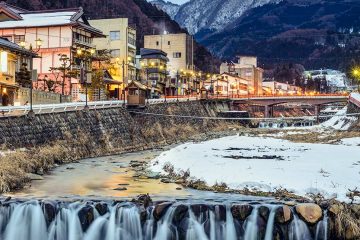
These Metropolises Turned Fleeting Olympic Fame Into Abiding Attractions
It’s a special honor for a city to be chosen to host the Olympic Games. It’s a chance to show off its country’s culture and traditions in addition to the athletic prowess of its citizens. Depending on the location, sometimes controversy does erupt, whether due to the cost of the Games, safety concerns or just plain politics.
It’s no surprise to hear that after some cities have poured millions into infrastructure for the Olympics, the buildings are met with a sad future of deterioration and ruin. For every Salt Lake City that turns the Games into long-lasting benefits, there’s a Sarajevo, an area torn apart by time and circumstance.
Still, world travelers should know that plenty of areas have transformed their Olympic investments into abiding attractions. Read on to learn more about six former Olympic host cities worth visiting.
Nagano, Japan
After this city in Japan’s Chubu district hosted the 1998 Winter Olympics, officials drew heat for going more than 50% over budget. Cries flew about corruption and cover-ups, and though promises of a revitalized tourism industry didn’t quite materialize, even critics had to admit that the Games made Nagano much more attractive to visitors.
How? The city has put its Olympic facilities to good use. The local government made the M-Wave speed skating arena into a museum and its actual Olympic Stadium into a sports park. There’s plenty to do apart from those structures, too.
You can tour famed wineries and breweries or attend Binzuru (an annual festival held on the first Saturday in August). Gastrophiles will adore the 280-year-old Yawataya Isogoro spice shop, and the so-called Japanese Alps are a short trip away.
Barcelona, Spain
Barcelona’s Estadi Olímpic Lluís Company still sees plenty of use after the 1992 Summer Olympics, but the real lingering impact of the Games can be seen in the area’s beaches. Once choked with refuse, they were cleaned up and turned into tourist-worthy stretches of sand.
Don’t just go for sun and sport, though. Architecture buffs will love the modernist structures that speckle the city, as well as the ancient Gothic Quarter whose bricked squares still show pocked wounds from the Spanish Civil War.
Late-summer festivals always draw crowds, as does La Boqueria, the largest food market in all of Europe. Also, don’t forget to learn more about Barcelona’s favorite artistic son at the Museu Picasso.
This sparsely populated island in the Bahamas will sweep you off your feet. Check out these stunning things to do Eleuthera.
Whistler, Canada
Long before it hosted the 2010 Winter Olympics, the Resort Municipality of Whistler had a well-deserved reputation for excellent cold-weather sports. Its pair of impressive peaks — Blackcomb and the titular Whistler — have always made for world-class skiing. However, organizers also made sure the Whistler Olympic Park wouldn’t sink into obscurity once the Games concluded.
A winter sports complex is, by its very nature, supposed to only be usable during the last months of the year, right? Not so with Whistler’s Olympic facilities. The Whistler Sliding Centre offers bobsled rides year round, while the Olympic Park proper has a summer biathlon and a sightseeing program.
Of course, winter allows for Nordic skiing, snowshoeing and tobogganing, and guests can even stay in the Whistler Athletes’ Centre.
Sydney, Australia
The Harbour City took more of an eclectic approach to transforming its 2000 Summer Olympic space. The Sydney Olympic Park has become a mixed-use entertainment district with plenty to do for both locals and visitors. In addition to self-guided tours, the Park serves up a plethora of family-friendly offerings such as a smartphone-directed orienteering course, laser tag, a plethora of sports and giant art installations.
Then there’s Sydney itself with all its charms. Stroll down Sydney Harbour Bridge before popping in to the Sydney Observatory. Head south to see Chinatown and enjoy awesome grub. Then stop by Darling Harbor to enjoy any number of museums, including the Australian National Maritime Museum and Sydney Wildlife World. Make sure to enjoy a coastline cruise, too!
Squaw Valley, California
Most cities on this list started out as significantly sized areas in their own right prior to their Olympic bids. But when Squaw Valley started bidding to host the 1960 Winter Olympics, it hadn’t even completed its initial construction. Today, though, it has transformed into one of the most impressive ski resorts in the United States.
Make no bones about it: Squaw Valley is definitely a winter-weather getaway. Slopes appropriate for every age and experience level are its primary draw. It also boasts several highly developed terrain parks sure to thrill snowboarders. Snow tubing, mini-snowmobiling, dog sledding and skyjumping (rope-assisted aerial gymnastics) are just a few of the additional activities.
Then there’s The Village at Squaw Valley, a continental-style enclave with excellent dining, drinking and shopping.
Whether you want to pick one of these places to visit in UK and thoroughly explore it, or add a few of these to your itinerary, you won't be disappointed.
Stockholm, Sweden
The Venice of Scandinavia first hosted the Games over a century ago in 1912 — and the stadium in which it held them still sees action. Yes, the Stockholm Stadium (which happens to be the oldest Olympic arena still in use) not only continues to host events, it also makes for great self-directed touring. The original, un-remodeled architecture is still in great shape.
From there, a simple stroll should open up to you this metropolis that sprawls over 14 islands. Stroll over any of the city’s many bridges to Södermalm where you can see the gorgeous Katarina Kyrka (a cathedral dedicated to Princess Catherine, mother of King Charles X of Sweden) and enjoy great eating and shopping.
Historic Gamla Stan contains the Royal Palace and the Nobel Museum, as well as a number of great scenic biking opportunities.
